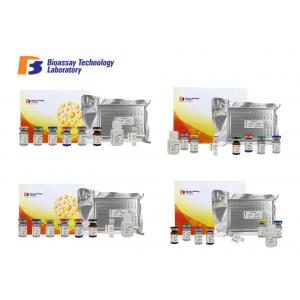
Add to Cart
Rat Fbg ELISA Test Kit Fibrinogen Immunoassays Test Kit With High Sensitivity and Specificity
Cat.No E0685Ra
Assay Principle
This ELISA Test Kit is an Enzyme-Linked Immunosorbent Assay (ELISA). The plate has been pre-coated with Rat Fbg antibody. Fbg present in the sample is added and binds to antibodies coated on the wells. And then biotinylated Rat Fbg Antibody is added and binds to Fbg in the sample. Then Streptavidin-HRP is added and binds to the Biotinylated Fbg antibody. After incubation unbound Streptavidin-HRP is washed away during a washing step. Substrate solution is then added and color develops in proportion to the amount of Rat Fbg. The reaction is terminated by addition of acidic stop solution and absorbance is measured at 450 nm.
Intended Use
This sandwich kit is for the accurate quantitative detection of Rat Fibrinogen (also known as Fbg) in serum, plasma, cell culture supernates, cell lysates, tissue homogenates.
Standard Curve Range: 0.05mg/ml - 20mg/ml
Sensitivity: 0.018mg/ml
Size: 96 wells
Reagent Provided
| Components | Quantity |
| Standard Solution (24mg/ml) | 0.5ml x1 |
| Pre-coated ELISA Plate | 12 * 8 well strips x1 |
| Standard Diluent | 3ml x1 |
| Streptavidin-HRP | 6ml x1 |
| Stop Solution | 6ml x1 |
| Substrate Solution A | 6ml x1 |
| Substrate Solution B | 6ml x1 |
| Wash Buffer Concentrate (25x) | 20ml x1 |
| Biotinylated Rat Fbg Antibody | 1ml x1 |
| User Instruction | 1 |
| Plate Sealer | 2 pics |
| Zipper bag | 1 pic |
Material Required But Not Supplied
Precautions
Assay Procedure
1. Prepare all reagents, standard solutions and samples as instructed. Bring all reagents to room temperature before use. The assay is performed at room temperature.
2. Determine the number of strips required for the assay. Insert the strips in the frames for use. The unused strips should be stored at 2-8°C.
3. Add 50μl standard to standard well. Note: Don’t add antibody to standard well because the standard solution contains biotinylated antibody.
4. Add 40μl sample to sample wells and then add 10μl anti-Fbg antibody to sample wells, then add 50μl streptavidin-HRP to sample wells and standard wells ( Not blank control well ). Mix well. Cover the plate with a sealer. Incubate 60 minutes at 37°C.
5. Remove the sealer and wash the plate 5 times with wash buffer. Soak wells with at least 0.35 ml wash buffer for 30 seconds to 1 minute for each wash. For automated washing, aspirate all wells and wash 5 times with wash buffer, overfilling wells with wash buffer. Blot the plate onto paper towels or other absorbent material.
6. Add 50μl substrate solution A to each well and then add 50μl substrate solution B to each well. Incubate plate covered with a new sealer for 10 minutes at 37°C in the dark.
7. Add 50μl Stop Solution to each well, the blue color will change into yellow immediately.
8. Determine the optical density (OD value) of each well immediately using a microplate reader set to 450 nm within 10 minuets after adding the stop solution.
Summary
1. Prepare all reagents, samples and standards.
2. Add sample and ELISA reagent into each well. Incubate for 1 hour at 37°C.
3. Wash the plate 5 times.
4. Add substrate solution A and B. Incubate for 10 minutes at 37°C.
5. Add stop solution and color develops.
6. Read the OD value within 10 minutes.
Calculation of Result
Construct a standard curve by plotting the average OD for each standard on the vertical (Y) axis against the concentration on the horizontal (X) axis and draw a best fit curve through the points on the graph. These calculations can be best performed with computer-based curve-fitting software and the best fit line can be determined by regression analysis.